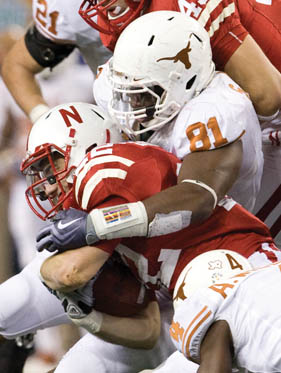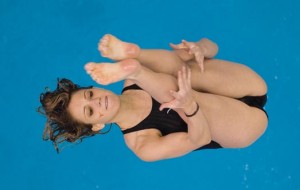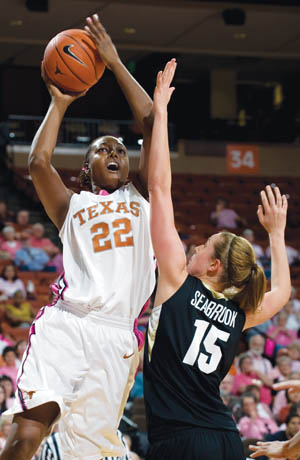Texas on the Tube
The soon-to-launch Longhorn Network represents a watershed moment in the history of broadcasting and collegiate athletics. How did it come to be, and what will it look like?

As staff members and consultants tossed around ideas for a Texas Longhorns television network a few years ago, one running joke was that programmers could throw up a test pattern with just the Longhorns logo and still draw a measurable Nielsen rating. That concept, however farcical, was at the low end of the University’s aspirations.
At the upper end was what has actually come to pass: the Longhorn Network, Texas’ 20-year, $300 million partnership with ESPN and marketing agency IMG College that will launch in August. This fall, it will produce one or possibly two Longhorns football games as the centerpiece of its 200 annual live events.
Even considering the time-honored tradition of Texas bragging, the Longhorn Network is a singular phenomenon. Notre Dame has a long-running deal with NBC for home football games, dozens of schools have scattered regional services, and the Big Ten has its 24-hour cable and satellite network. Nothing else, however, combines the Longhorn brand with the power of ESPN. And here’s the punch line, which will doubtless tickle Texas fans and infuriate everyone else: from the standpoint of the University officials who cut the deal with ESPN, it really wasn’t about money.
“We had this dream, and we had it for a long time,” says athletics director DeLoss Dodds. “What we started out thinking about, four or five years ago, is where we’re ending up, being able to show all our sports across the state. The only difference was money.”

Sam Acho
The Longhorn Network is owned by ESPN and operates under a license with the University and its athletics marketing partner, IMG College. IMG will receive 17.5 percent of the proceeds (about $52.5 million), with the rest going to the University. Texas will receive about $50 million for the deal’s first five years (starting at $10.98 million a year and increasing by 3 percent annually). Half of the proceeds will go to athletics and the rest to the University for academics, including $1 million endowed chairs for physics and philosophy.
ESPN has budgeted $26 million per year for the network—$15 million for production and $11 million for overhead—and has agreed to spend $13 million for studio facilities. Once combined revenue over the life of the deal hits $295 million, the University will receive 70 percent of the profits. The Longhorn Network will air 24/7, on satellite, cable, and telco services to be negotiated by ESPN.
Programming will include news and studio shows, plus live events; non-athletic events will account for 10 percent of air time. The University has approval rights regarding content. It took imagination, vision, and substantial institutional ego to make the network happen. Conventional wisdom assumed a UT network would take the form of a regional sports network like Fox Sports Southwest or Fox Sports Houston, which hold rights to the state’s NBA and MLB franchises.
Chris Plonsky, women’s athletics director, says she and athletics director DeLoss Dodds were encouraged to think outside geographic boundaries by Skip Prince, a Chicago television consultant. Prince proposed that the Texas network, as with Comcast’s USA Network or Fox’s FX, become a hybrid sports-entertainment channel. And while he thought the University should be open for bids, he saw ESPN as the ideal partner.
“It would have been quite easy to build a straightforward RSN,” Prince says. “To build something with this overarching entertainment piece and associate it with ESPN, which hadn’t done anything like this before, and to build an on-campus studio, all that was the hard road,” he says. “I don’t see people taking the hard road too often.”
The genesis of the Longhorn Network dates to 2003, when the university partnered with Time Warner Cable to launch a subscription video-on-demand service. BevoD, which costs $3.99 per month, is available on Time Warner systems in Austin, Dallas, San Antonio, and Waco and features game re-airs, coaches’ shows, interview shows, and more..
“[BevoD] was an exercise to see if we could create and aggregate material ourselves, to see what we could create and what it would draw,” Plonsky says. “At its height, it might have had 5,000 to 6,000 subscribers. It was almost like an ongoing beta test, although it has begun to make a little money.”

Shelby Cullinan
In 2006, with the Big 12 nearing the end of its television contract with ABC, Texas and Nebraska hired Prince to study the feasibility of an all-Big 12 network similar to the Big Ten Network, which the league had just launched in partnership with Fox. When that study indicated in fall 2007 that Texas would be better served going it alone, Plonsky says, Athletics and IMG got to work on ideas for a standalone service devoted to the Longhorns.
“Nobody had thought to take it past eight men’s basketball games and maybe some Olympic sports,” Plonsky says. “There was a Jayhawk Network (in Kansas) and a Cyclone Network (at Iowa State). Baylor and Texas A&M had deals with Fox, and Texas Tech had a network that Bob Knight and his son marketed. “Everybody was doing third tier, but nobody had uttered the words ‘our own channel.’”
That would quickly end. The conference realignment brouhaha of 2010, when Texas schools in the Big 12 flirted with the Pac-10, resulted in what Plonsky described as a “respectful pause” in negotiations. But with Prince’s “think big” mantra in mind, negotiations heated up once more in fall 2010. “There were a lot of people bringing proposals—independent investors, people who had launched channels internationally, and the traditional media partners, Fox and ESPN,” Plonsky says. “This was competitive. There were many alternatives, and all of them had a handsome financial element. Every offer exceeded our expectations.” ESPN prevailed, Dodds says, because “it played in a different ballpark than anyone else. They have a confidence that they can make this thing that big. That was the difference.”
ESPN’s point people in Austin will be Dave Brown, the network’s longtime college football scheduler and matchmaker, who will head programming, and Stephanie Druley, BJ ’89, Life Member, who will lead production.
Both had reasons to move from Connecticut, ESPN’s home base, to Austin. Brown, a native of upstate New York, was preceded to Austin by his parents and two siblings. Druley’s office in Bristol, where she was coordinating producer for ESPN’s NFL studio programs, was covered with Longhorns and Houston Oilers memorabilia, and she said in an interview with the Houston Chronicle in 2008 that she was resigned to calling Connecticut home. “After they put up the fourth building,” Druley said at the time, “I realized that ESPN isn’t going anywhere.”

Ashley Gayle
As it turns out, she was mistaken. ESPN was coming to Texas, and so is she. “It was not an easy decision to come back,” she says. “I loved working with the NFL. But if there was anything that could take me away from it, it would be Texas, because I have such a passion for the University and the sports there. I’ve been passionate about Texas since I was 12 years old. I didn’t have a second choice on where I wanted to go to school.”
Druley will be in charge of assembling a staff of about 70. That number will be augmented by UT students, she says, “but this isn’t a student network. This will be the quality of ESPN.” Even before she packed up her office for the move, Druley got going, traveling to Austin in April to film a roundtable with Mack Brown, Ricky Williams, Colt McCoy, and Vince Young (“That’s going to be good television,” she says) and to tour the Jones Communications Center, where she attended classes in order to scope out its potential for the Longhorn Network.
Druley’s specialty is studio shows, and one of the Longhorn Network’s staples will be a 10 p.m. newscast modeled after SportsCenter, called something like All Things Longhorn. She will be in charge of hiring on- and off-camera talent and says the Longhorn Network will develop its own signature faces while also using ESPN analysts in Bristol. Since the network debuts in August, its initial schedule will be heavy on football, with live updates from practice that Brown promises will offer unprecedented access to the Longhorns.
“There are several segments of each practice that are routine drills, and we’ll be on the air live as those are taking place,” Brown says. “We won’t cover the segments dedicated toward particular game presentation. We’ll break away during that time for interviews. “This will give us a chance to talk to Mack [Brown], to the student-athletes and the coordinators and give viewers a real sense of what is going on. We’ll really put our viewers inside the football program and get them in a serious mode to think about the next opponent.”
Prime-time schedules, of course, will vary according to season and live event schedules. During the fall, Brown says the live practice show might re-air in prime time for viewers who missed it. Brown says the network will re-air relevant ESPN and ABC shows, such as last year’s documentary on Heisman Trophy winner Ricky Williams, and Brown has assembled a bank of 60 classic Texas football games that will occasionally air.“But since we’re sitting here in the middle of campus, we’ll focus on live events and current events more than looking to the past,” he says.
The Longhorn Network will likely air only one live football game each season (possibly two the first season), but every Texas game will be preceded by a two-hour pregame show featuring ESPN talent from the stadium, if the game is on an ESPN network, or announcers at the stadium and ESPN analysts in Bristol if the game is on the Longhorn Network. Network anchors also will travel to selected road games, including the Oklahoma game in Dallas and the UCLA game at the Rose Bowl in Pasadena, Calif.
Alternate programming, such as statistical updates like those offered on the NFL’s RedZone Channel, will air during games, followed by postgame interviews. Games to which the network has access will later re-air. About 10 percent of the network’s programming will focus on non-sports topics. UT president Bill Powers says he hopes the network also will include “Nova and Discovery Channel-type shows,” adding, “We’ll rely on our faculty expertise in a lot of areas.” Proceeds from the channel that are funneled to academics will be used to attract and keep faculty members, Powers says. At least two more endowed chairs are in the works in the next five years.
Powers’ point man in assembling that portion of the schedule is Austin consultant Paul Walker, who says non-sports programming will range from one-minute vignettes on students, professors, and alumni to Commencement exercises. Plans include a Longhorn Network edition of Austin City Limits, featuring campus favorites like Willie Nelson, Joe Ely, and Eric Johnson; Master Class, featuring faculty lectures on topics from the Civil War to the expanding universe; and presentations and concerts branded “Live From UT-Austin. “

Laura Sogar
Alumni Michael Dell, Red McCombs, Matthew McConaughey, Ben Crenshaw, and others will be featured in a half-hour interview format. The channel also will air documentaries produced by faculty and staff, such as When I Rise, on opera star Barbara Smith Conrad, and Tattooed Under Fire, on Iraq veterans whose tattoos reflect their combat experiences.
“You’ll see some short pieces on the nightly news show about things happening on campus, professors and students and alumni doing things that make a difference,” Walker says. “We’ll try to give you a feeling about what is important on campus on any given day.” As news develops, such as the killing of Osama Bin Laden in May, Brown says the network could tap campus experts on virtually every academic specialty to provide CNN-style analysis. “If there’s a chance to do a one-hour show on a topic like (Bin Laden’s death) and get it on the air quickly, we’ll do it,” Brown says. “That’s part of our mission, too.”
Unique products like the Longhorn Network invariably produce unique challenges and controversies. Texas’ Big 12 competitors are concerned, for example, that the Longhorns could gain a recruiting advantage by airing Thursday and Saturday high school games (University Interscholastic League rules prohibit live Friday game broadcasts during the regular season).
“We’re looking at a high school game of the week, which will be a great element,” Brown says. “We’ll focus on the star players and the great rivalries. We may even show a six-man game for the fun of it.”
Another springtime flare-up concerned the issue of editorial control—specifically, a contract clause that allows Texas to request the dismissal of on-air talent that “does not reflect the quality and reputation desired by UT for the Network based on inappropriate statements made or actions taken by such talent.” The clause is similar to language in contracts between colleges and their radio networks, and Brown says it is intended to address off-the-field or on-air indiscretions, not to censor criticism of Texas players or coaches.
“We are going to be editorially sound in every production,” Brown says. “We will have a home team, Texas, and a road team, and we will treat every production like we would on ESPN, in a fair and balanced manner.”
From the athletics department’s perspective, Plonsky says, “Our fans have told us that we need to offer legitimate programming. If something happens, they want to hear about in the same way that ESPN would report it on SportsCenter.” Of the $300 million that the University will receive from ESPN, the impact on UT athletics is as minimal as $5 million can be. Broadcasting revenue accounts for about $30 million of the department’s $150 million budget, and Dodds believes the ESPN connection will have value beyond the financial bottom line.
“I don’t think that will touch what this will do for the University in terms of branding and our future,” he says. “The timing is perfect because of all the changes the University is going through. It gives us a vehicle at a time we need a vehicle to put out our message. “It enables us to support the university and build a relationship with the academic side. We’re differently managed, and we live in a different world in a way, but we have the same goals. We work with young people, and the fact that we can generate revenue is a positive thing.”
David Barron is a reporter for the Houston Chronicle. Photos courtesy of UT Athletics.

















No comments
Be the first one to leave a comment.